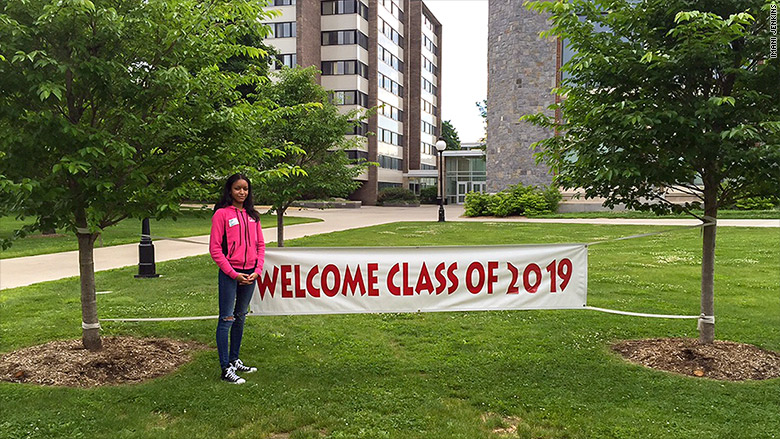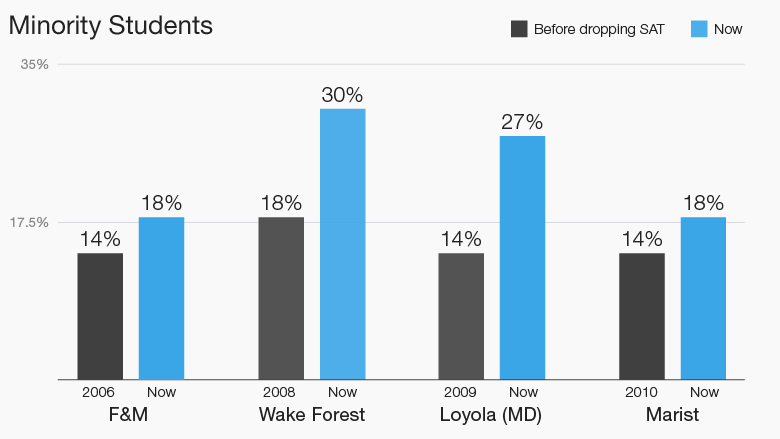
Bombed the SAT? Not to worry.
A growing number of schools -- about 850 and counting -- no longer require applicants to submit their scores. And college officials say that a test-optional policy helps them attract strong applicants that may not have previously applied -- including students of color, and those from low income families.
Data shows tests like the SAT are biased against students from low-income households. Poorer students tend to perform worse on the test. The difference might be the costly prep courses, books and tutors, some experts say. Blacks and Hispanics also consistently score lower on the SAT than whites.
The new thinking is that dropping the SAT requirement might encourage more low-income students to apply. But does it really increase diversity among enrolled students?
While the academic research is mixed, some of the schools that implemented the policy early on have seen big changes in their student bodies.
Related: George Washington University is ditching SATs
Before Wake Forest made its admission process test-optional for freshmen entering in 2009, about 18% of the students were non-white. The following year, the number jumped to 23% and it now stands at 30%.
The share of students from low-income households who are eligible for Federal Pell grants also shot up to 11% last year, compared to 7.5% the year before the policy was implemented, according to data provided by the school.

SAT scores don't help as much as high school GPA and curriculum do in determining whether a student will be successful in college, research has found. Enrolled students who did not submit test scores are just as likely to graduate on time as those who did.
"The single best predictor of a student's likelihood to succeed is their GPA," said Marc Camille, the VP for enrollment management and communications at Loyola University Maryland. He helped conduct research specific to the school, which matched nationwide findings.
Since going test-optional in 2010, the percentage of minority students at Loyola jumped 13%, now making up more than a quarter of the student body.
Related: How I got into an Ivy League school
Test-optional polices are more popular among smaller, liberal arts schools that already say they look beyond the numbers.
At Marist College in New York, which dropped the requirement for the freshman class enrolling in 2011, the share of minority students has jumped from about 14% to nearly 18%.
"I think it makes a huge difference to see a student as a whole person instead of just a number," said Imani Jenkins, a freshman at Marist.
Jenkins is an African-American from Washington, D.C., who didn't submit her score. While she was third in her graduating class at Cesar Chavez Parkside charter high school, she thinks it was her SAT score that kept her from getting into other schools like Duke and Stanford.
"It seems like some schools just want students who are book-smart and plan on making a lot of money to give back to the school. To me, it's more about making a difference in the world than the money," she said.
At Franklin & Marshall College there has been a more modest increase in the share of minority students over the past decade. The school, in Lancaster, Pennsylvania, was one of the first to go test-optional. But it has seen a bigger jump in enrolled low-income students than some of the other schools: from 7% to 18%.
Part of that's due to an expansion of financial aid, said Eric Maguire, the VP of admissions and financial aid.
"It allowed those who got in, but maybe didn't have the resources, to now enroll," he said.
At all four schools, about one-third of applicants don't submit their test scores, and a lot are getting in. At Wake Forest, for example, 30% of applicants did not submit scores -- and 30% of the current student body were non-submitters.
Related: Your degree will earn you the most from these colleges
Not all colleges have seen the same changes. Fairfield University in Connecticut didn't report much of a change in diversity after the school ditched the SAT in 2010. About 17% of the student body is non-white.
"Our racial and ethnic diversity has changed slightly, but there's probably a lot of factors involved in that," said Karen Pellegrino, the dean of enrollment.
But increasing diversity is a priority at Fairfield, she said. The school has also been recruiting at low-income high schools and offering scholarships to some students from nearby Bridgeport.
All four school say they have also diversified where they recruit, visiting different states and high schools in low-income areas.
"It's a combination of things, but I would probably give a majority of the credit to the test-optional policy because without that, a lot of those kids probably wouldn't have applied even if we did recruit in their area," said Sean Kaylor, the VP of enrollment Management at Marist College.
Critics say going test-optional is just a ploy to appear more selective by attracting more applicants and pushing up average SAT scores. While the number of applicants has expanded at many schools, score averages don't always go up. Loyola's numbers, for example, have not changed.
"We thought about how many great students out there never apply because of their SAT score. If we're true to our mission, to make education available to all students, then GPA is the best predictor for us," said Loyola's Camille.
